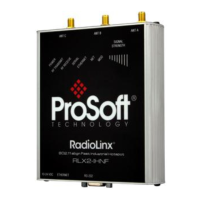Detailed Radio Configuration / Diagnostics RLX2 Series ♦ 802.11a, b, g, n
User Manual Industrial Hotspot
Page 88 of 161 ProSoft Technology, Inc.
May 8, 2013
If a Master radio detects radar, it issues a channel change announcement to all
Clients and Repeaters in the network. Then it moves to a new channel within the
Channel Move Time. (Typically, this move time is 500 milliseconds or less.) If the
selected channel was not previously checked for the presence of radar, the
Master radio must do so for the Channel Availability Check Time before it can
begin to transmit. If the newly-selected channel is not a DFS channel, or if the
channel was previously monitored for radar since the radio was powered on,
transmissions can begin immediately.
During the Channel Availability Check Time, a radio blinks all three amber Signal
Strength LEDS approximately once per second. If radar is detected on the new
channel during the Channel Availability Check Time, the Master selects another
channel and begins the process again.
A Repeater detecting radar, in addition to stopping data transmission, notifies its
Parent of the presence of radar. Each unit receiving a radar notification from a
child treats it the same as if it had detected radar itself and acts accordingly.
Thus radar notifications always reach the Master and a channel change is
affected.
After a Master successfully selects a DFS channel, radios in Repeater mode will
connect to the Master and scan for RADAR for an additional 60 seconds
(Channel Availability Check Time). If a chain of Repeaters ultimately connects to
a Master using a DFS channel, the time to connect is 60 seconds for each
Repeater in the chain as DFS channels are initially scanned for RADAR
transmissions.
6.8.2 DFS Auto Select
One of the Master channel selection options is DFS Auto Select.
With this selection the radio randomly selects a DFS channel for operation. The
actual channel in operation is always shown in the Current Channel display:

